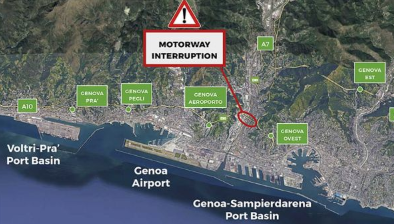Diversion routes for rail freight to and from Genoa

International rail freight traffic to and from Genoa in Italy is currently limited on certain routes, said the Rhine-Alpine Corridor management. Genoa is the most southern destination on the Rhine-Alpine corridor, which connects the Italian northern coast with the Port of Rotterdam. The collapse of the Morandi bridge damaged several underlying railway lines, some of them part of the international railway corridor.
Voltri Mare station is accessible, but train traffic to this main freight hub is facing certain restrictions. National and international trains are diverted on the route Voltri Mare – Sestri Ponente – Savona – XXmiglia. They are re-routed via Ovada – PP Corvi – Genova Voltri/Genova Voltri Mare or via Mignanego – Genova PP – Genova Brignole. On the first diversion route the transport of dangerous goods is not permitted. Regarding the latter diversion route, locomotive shunting must be done in Principe or Brignole, noted the Rhine-Alpine Corridor.
Voltri Mare is the main station for international rail freight traffic. Earlier, Italian railway undertaking Ferrovie dello Stato Italiane (RFI) said the Voltri Mare station operates as usual, with trains departing towards the north, west and east of Italy. Neighbouring station La Spezia is not impacted at all.

Suspended lines
Trains traffic from and to Genova Marittima is currently suspended due to inaccessibility of Genova Marittima installation, said the Rhine-Alpine Corridor. Genova Marittima is situated directly on the coast. It connects to Sampierdarena via the Submarine Line. Traffic on this railway line is suspended, said RFI earlier. From Sampierdarena, freight traffic is directed to northbound destinations such as Ovada, Milan and Turin via the Bastioni Line. According to sources, traffic on this line is also halted, with alternative routes available.
According to the Ports of Genua, the impact on railway traffic is due to the collapse of the bridge on the Polcevera Yard. “The rail tracks of the Polcevera Yard were directly involved by the collapse of the Morandi Bridge and are currently blocked by ruins which have to be removed in order to repair damaged infrastructures and reactivate train circulation”, said the company. The Polcevera Yard is the junction of two rail freight lines and one passenger line. Both the Submarine Line and the Bastioni Line cross through this yard.
Construction works
RFI has carried out inspections to assess which restoration operations are required on the damaged infrastructure, it commented. “RFI has already made arrangements with the contractors that will carry out the works. They will start as soon as the permit is issued by the Italian authorities,” they said last week. Works to restore the normal infrastructure functionality are expected to take around two weeks.
Furthermore, the eastern portion of the Morandi bridge, which is still standing, runs over the Campasso Yard, connecting the eastern area of the port to northbound lines. Operations on the Campasso Yard are currently suspended due to ongoing improvement works by RFI, not related to the bridge accident, the Ports of Genua explained.
Morandi bridge collapse
On 14 August the Morandi bridge in Genoa collapsed. The bridge used to run across the Polcevera stream and was part of the A10 toll motorway, connecting the districts of Sampierdarena and Cornigliano. Due to the collapse, at least 43 people died. The railway lines under the bridge were crushed and left unoperational.
Also read: Rhine-Alpine corridor not affected by collapse Morandi bridge
You just read one of our premium articles free of charge
Want full access? Take advantage of our exclusive offer






